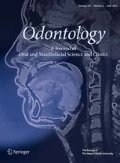Abstract
To investigate the stimulating effect of endodontic medications on the mRNA expression of some osteogenesis-related genes associated with reparative dentinogenesis and hard-tissue formation, human dental pulp cells (D824 cells) were treated with calcium hydroxide (Ca (OH)2), formocresol, or guaiacol. The effect on growth was determined by growth curves of D824 cells treated for 1–3 days with 0.03–0.3 mM Ca (OH)2, 0.0007%–0.0014% formocresol, or 0.24–2.43 mM guaiacol. The mitotic activity of individual cells and the mRNA expression of the osteogenesis-related genes for alkaline phosphatase (ALP), type I collagen (COL-1), and bone sialoprotein (BSP) in the cells treated for 24 h with the same concentrations of the medications as described above were determined by colony-forming efficiency and by real-time quantitative reverse transcription polymerase chain reaction (qRT-PCR) analysis, respectively. Cellular growth and mitotic activity were scarcely affected by Ca (OH)2, but were significantly reduced by formocresol or guaiacol. The mRNA expression of the osteogenesis-related genes was little affected by Ca (OH)2 or formocresol, but was significantly enhanced by guaiacol. The results indicate that guaiacol may stimulate the mRNA expression of genes associated with reparative dentinogenesis and hard-tissue formation in human dental pulp cells, suggesting that the novel property of guaiacol provides new insights into the utilization of guaiacol in endodontic therapy.
References
Bahrololoomi Z, Moeintaghavi A, Emtiazi M, Hossein G. Clinical and radiographic comparison of primary molars after formocresol and electrosurgical pulpotomy: a randomized clinical trial. Indian J Dent Res 2008;19:219–223.
Zander HA. Reaction of the pulp to calcium hydroxide. J Dent Res 1939;18:373–379.
Leonardo MR, da Silva LAB, Leonardo RT, Utrilla LS, Assed S. Histological evaluation of therapy using a calcium hydroxide dressing for teeth with incompletely formed apices and periapical lesions. J Endod 1993;19:348–352.
Goldberg M, Six N, Decup F, Lasfargues J-J, Salih E, Tompkins K, Veis A. Bioactive molecules and the future of pulp therapy. Am J Dent 2003;16:66–76.
Beertsen W, VandenBos T, Everts V. Root development in mice lacking functional tissue non-specific alkaline phosphatase gene: inhibition of acellular cementum formation. J Dent Res 1999;78:1221–1229.
Chen J, McCulloch CA, Sodek J. Bone sialoprotein in developing porcine dental tissues: cellular expression and comparison of tissue localization with osteopontin and osteonectin. Arch Oral Biol 1993;38:241–249.
D’souza RN, Bachman T, Baumgardner KR, Butler WT, Litz M. Characterization of cellular responses involved in reparative dentinogenesis in rat molars. J Dent Res 1995;74:702–709.
Hwang Y-C, Hwang I-N, Oh W-M, Park J-C, Lee D-S, Son H-H. Influence of TGF-β1 on the expression of BSP, DSP, TGF-β1 receptor I and Smad proteins during reparative dentinogenesis. J Mol Histol 2008;39:153–160.
Tsutsui TW, Inaba T, Fisher LW, Robey PG, Tsutsui T. In vitro chromosome aberration tests using human dental pulp cells to detect the carcinogenic potential of chemical agents. Odontology 2006;94:44–50.
Chang Y-C, Tai K-W, Huang F-M, Huang M-F. Cytotoxic and nongenotoxic effects of phenolic compounds in human pulp cell cultures. J Endod 2000;26:440–443.
Yazaki K, Mimura T, Kawaguchi M. Activating effects of phenolic compounds on the osteogenic cell line. Bull Tokyo Dent Coll 1993;34:141–145.
Mimurai T, Yazaki K, Sawaki K, Ozawa T, Kawaguchi M. Hydroxyl radical scavenging effects of guaiacol used in traditional dental pulp sedation:reaction kinetic study. Biomed Res 2005;26:139–45.
Moriguchi N, Hinoi E, Takarada T, Matsushima N, Uno K, Yoneda Y. Oral administration of phenolic antidiarrheic ingredients prevents ovariectomy-induced bone loss. Biochem Pharmacol 2007;73:385–393.
Murakami Y, Hirata A, Ito S, Shoji M, Tanaka S, Yasui T, Machino M, Fujisawa S. Re-evaluation of cyclooxygenase-2-inhibiting activity of vanillin and guaiacol in macrophages stimulated with lipopolysaccharide. Anticancer Res 2007;27:801–807.
Aubin JE, Bonnelye E. Osteoprotegerin and its ligand: a new paradigm for regulation of osteoclastogenesis and bone resorption. Osteoporos Int 2000;11:905–913.
Garcia JMQ, Martins MD, Jaeger RG, Marques MM. Immunolocalization of bone extracellular matrix proteins (type I collagen, osteonectin and bone sialoprotein) in human dental pulp and cultured pulp cells. Int Endod J 2003;36:404–410.
da Silva RAB, Leonardo MR, da Silva LAB, de Castro LMS, Rosa AL, de Oliveira PT. Effects of the association between a calcium hydroxide paste and 0.4% chlorhexidine on the development of the osteogenic phenotype in vitro. J Endod 2008;34:1485–1489.
Zhang Q, Fan M, Bian Z, Chen Z, Zhu Q. Immunohistochemistry of bone sialoprotein and osteopontin during reparative dentinogenesis in vivo. Chin J Dent Res 2000;2:38–43.
Tye CE, Hunter GK, Goldberg HA. Identification of the type I collagen-binding domain of bone sialoprotein and characterization of the mechanism of interaction. J Biol Chem 2005;280:13487–13492.
Rølling I, Melsen B. Dentin formation in formocresol pulpotomized primary monkey teeth studied by tetracycline and 3H-proline incorporation. Scand J Dent Res 1979;87:403–414.
Cunningham KW, Lazzari EP, Ranly DM. The effect of formocresol and glutaraldehyde on certain enzymes in bovine dental pulp. Oral Surg Oral Med Oral Pathol 1982;54:100–103.
Author information
Authors and Affiliations
Corresponding author
Rights and permissions
About this article
Cite this article
Kato, T., Shirayama, K., Tsutsui, T.W. et al. Induction of mRNA expression of osteogenesis-related genes by guaiacol in human dental pulp cells. Odontology 98, 165–169 (2010). https://doi.org/10.1007/s10266-010-0129-0
Received:
Accepted:
Published:
Issue Date:
DOI: https://doi.org/10.1007/s10266-010-0129-0

